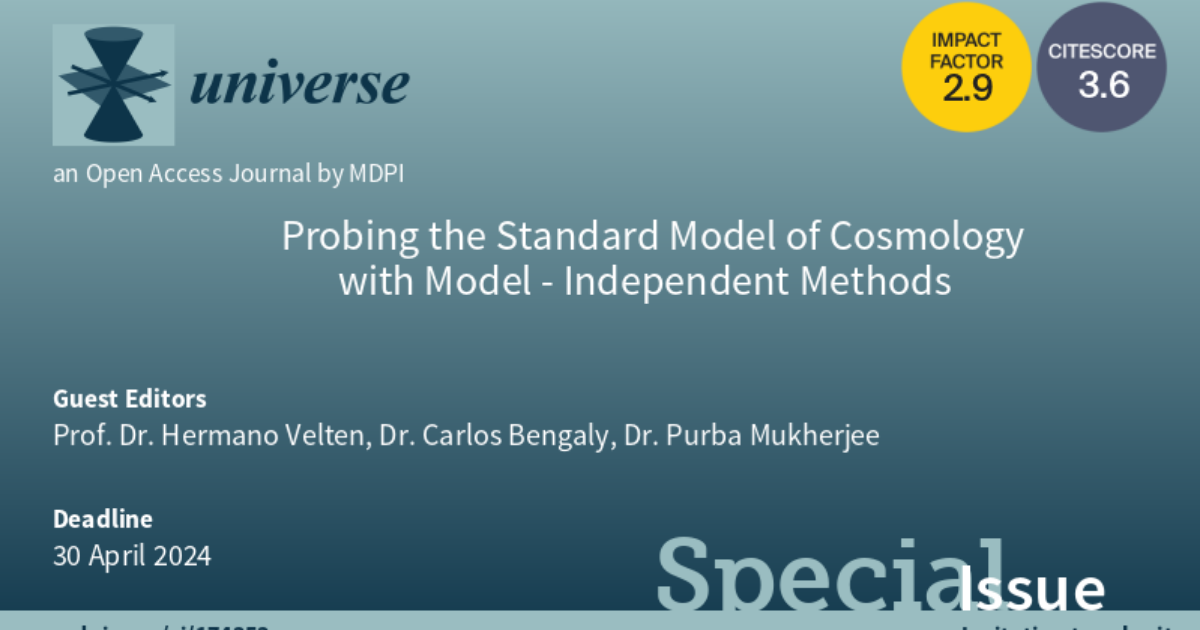Probing the Standard Model of Cosmology with Model-Independent Methods
A special issue of Universe (ISSN 2218-1997). This special issue belongs to the section "Cosmology".
Deadline for manuscript submissions: 30 April 2024 | Viewed by 1532

Special Issue Editors
Interests: cosmology; astrophysics; dark matter; dark energy; general relativity and its extensions
Special Issues, Collections and Topics in MDPI journals
Interests: cosmology
Special Issue Information
Dear Colleagues,
The standard model of cosmology has been successfully described by the ΛCDM paradigm, namely, a model dominated by cold dark matter and the Cosmological Constant Λ, since the late 1990s. This scenario has been able to explain cosmological observations, e.g., the power spectrum temperature fluctuations of the Cosmic Microwave Background, (CMB), the large-scale clustering of galaxies and quasars (LSS), and the luminotisy distance of Type Ia Supernovae (Sne) with unprecedented precision. Still, this model is plagued with theoretical caveats, such as the coincidence problem, not to mention observational issues, e.g., the tension between the Hubble Constant measured by observations in the local (from Sne) and in the primordial universe (from CMB). This raises the question whether ΛCDM is truly the best model that can describe the observed universe. Given the advent of computational techniques, such as machine learning, it has become crucial to tackle these theoretical and observational problems with these methods, as they are able to provide a model-agnostic view of the observed universe, especially in light of upcoming cosmological redshift surveys such as Euclid, DESI, J-PAS, and SKA, to name a few. Therefore, this Special Issue aims to cover the recent advances in model-independent methods developed and deployed for the sake of cosmological inference regardless of any assumption on dark matter, dark energy, and the nature of such components.
Prof. Dr. Hermano Velten
Dr. Carlos Bengaly
Dr. Purba Mukherjee
Guest Editors
Manuscript Submission Information
Manuscripts should be submitted online at www.mdpi.com by registering and logging in to this website. Once you are registered, click here to go to the submission form. Manuscripts can be submitted until the deadline. All submissions that pass pre-check are peer-reviewed. Accepted papers will be published continuously in the journal (as soon as accepted) and will be listed together on the special issue website. Research articles, review articles as well as short communications are invited. For planned papers, a title and short abstract (about 100 words) can be sent to the Editorial Office for announcement on this website.
Submitted manuscripts should not have been published previously, nor be under consideration for publication elsewhere (except conference proceedings papers). All manuscripts are thoroughly refereed through a single-blind peer-review process. A guide for authors and other relevant information for submission of manuscripts is available on the Instructions for Authors page. Universe is an international peer-reviewed open access monthly journal published by MDPI.
Please visit the Instructions for Authors page before submitting a manuscript. Submitted papers should be well formatted and use good English. Authors may use MDPI's English editing service prior to publication or during author revisions.






